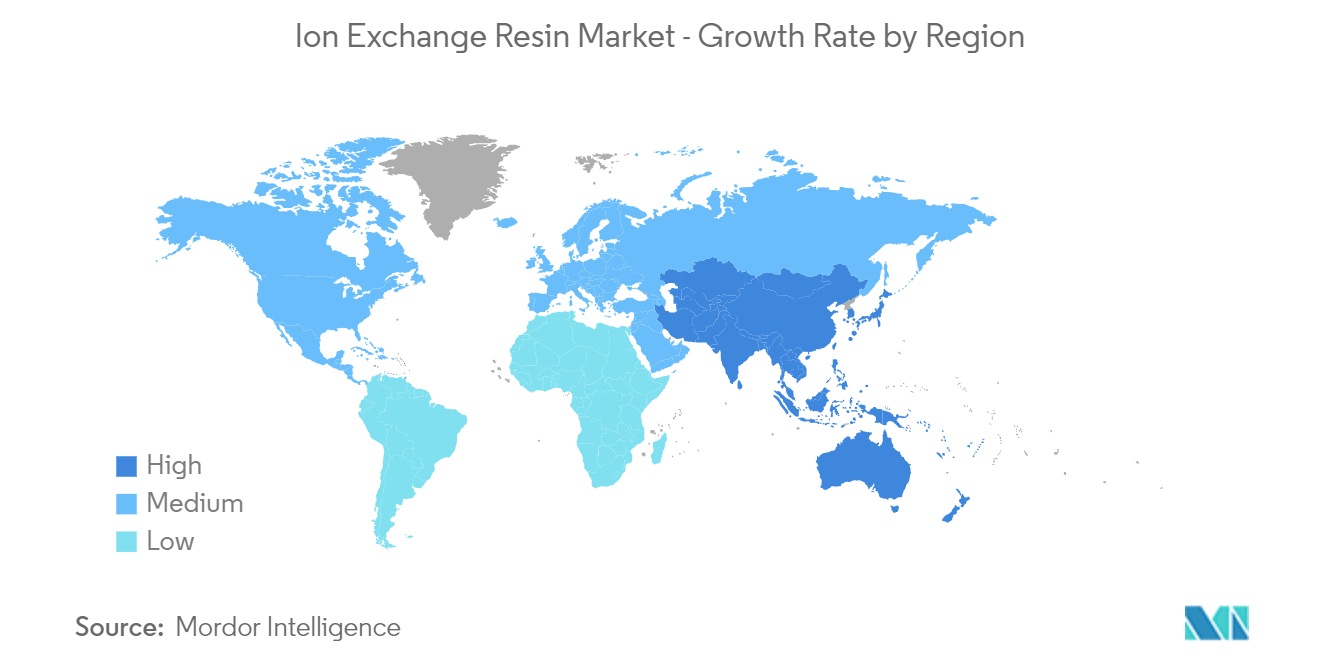Market Trends of Ion Exchange Resin Industry
Water Treatment Segment to Drive the Market
- Ion exchange resins are commonly used as a water treatment agent to remove trace metal ions, organic compounds, and pollutants from water.
- Water treatment applications are increasing lately, owing to the strong demand for freshwater resources. Water recycling is a multi-stage process in wastewater treatment plants. The ion exchange treatment process is commonly used for water softening or demineralization. It is also used for removing other substances from water in processes such as de-alkalization, de-ionization, and disinfection. These are used for both industrial and municipal purposes.
- Recently, ion exchange resins is increasingly used to create drinking water. Specialized resins are designed to treat various contaminants, including perchlorate and uranium.
- Many resins, such as strong base/strong anion resin, are designed to remove nitrates and perchlorate. There are also resin beads that can be used for water softening.
- Resin materials contain a finite exchange capacity. Each of the individual exchange sites will become full with prolonged use. When it is impossible to exchange ions, the resin must be recharged or regenerated to restore it to its initial condition. The substances used for this include sodium chloride, hydrochloric acid, sulfuric acid, or sodium hydroxide.
- The spent regenerant is the primary substance remaining from the process. It contains not only all the ions removed but also extra regenerations with high total dissolved solids. It can be treated in a municipal wastewater facility, while discharges may require monitoring.
- The efficacy of ion exchange for water treatment can be limited by mineral scaling, surface clogging, and other issues contributing to resin fouling. Pretreatment processes such as filtration or adding chemicals can help reduce or prevent these issues.
- Germany includes Europe's largest industrial wastewater treatment market, with almost 3,000 treatment plants. Over 920 million cubic meters of industrial wastewater are treated annually in the country before being discharged to the outside environment.
- The North American water and wastewater treatment market is also rapidly growing due to the high demand for treated water from the beverage and pharmaceutical industries in countries such as the United States. Expansion of the Lakeshore Wastewater Treatment Plant, a USD 43 million project, entails the development of a wastewater treatment plant in Ontario, Canada. Construction began in Q4 2021 and is expected to complete in Q2 2023. The project aims to address the region's wastewater and sewage needs. The project is expected to increase the capacity by 70%.
- With the increasing need for water treatment globally, the demand for ion exchange resins is projected to grow through the forecast period.

Asia-pacific to Dominate the Market
- Asia-Pacific is expected to dominate the global ion exchange resin market during the forecast period.
- China exports ion exchange resin mainly to the United States and is the largest exporter globally. In China, the demand for ion exchange resins for the applications in water treatment applications is growing at a fast pace. The increasing demand for purer and cleaner resins for usage in food and beverages, chemical, pharmaceutical, and power industries and companies investing in technology and R&D shall augment the market growth.
- In the Asia-Pacific region, China is the largest water consumer country. It contains 10,113 water treatment plants that treat wastewater for 95% of municipalities and 30% of rural areas. Moreover, China plans to build or renovate 80,000 km of sewage collection pipeline networks and increase sewage treatment capacity by 20 million cubic meters/day between 2021-2025.
- In the 14th Five-year Plan, China published new guidelines for wastewater reuse, which mandated increasing the proportion of sewage. It must be treated to reuse standards to 25% by 2025.
- Furthermore, India is among the largest water consumers in the world and needs around 740 billion cubic meters of water per year to meet the demand. However, depleting groundwater and increasing water demand are driving the dependency on water treatment in the country.
- In South Korea, in February 2023, SK Ecoplant Co. announced the expansion of its portfolio in the water industry through localizing core technology to produce ultrapure water. The company signed an R&D agreement with Sepratek, a Korean company specializing in membrane manufacturing and processes, to invest in core technologies for ultrapure water (UPW).
- The above factors are expected to drive the demand for Ion-exchange resins in the Asia-Pacific region during the forecast period.


